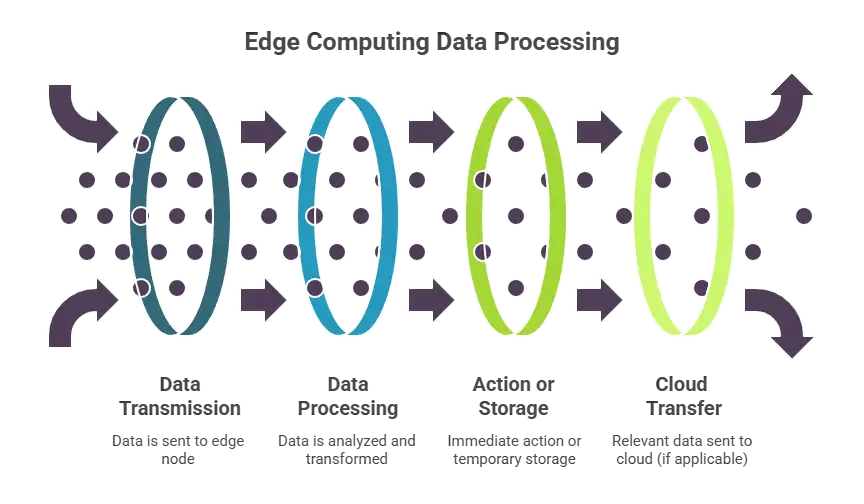Lafayette IT Support Provider Explains: Cloud vs. Edge Computing
Most modern businesses are aware of the value of using cloud services.
In fact, 96% of businesses now store data on a public cloud infrastructure. However, cloud computing is not your only choice when it comes to storing data off-site. If your data is still on-prem, it may be worth comparing cloud vs. edge computing before migrating.
| “Whether you choose cloud or edge computing, working with experts who can help you configure it correctly will ensure you get the most out of your data storage solution.” – Eric Thibodeaux, Co-Founder of InfoTECH Solutions |
Cloud and edge computing share several key benefits. In either case, you can adjust your computational resources to match demand without needing to buy or manage physical infrastructure. Both also help control costs by allowing you to only pay for what you use.
Still, one option may be better suited to your specific needs. This article from a reliable IT support provider in Lafayette is here to help you make an informed decision between cloud and edge computing. We will explore what each technology is, when to use them, and whether a hybrid approach is a viable option.
What Is Edge Computing? Is It The Opposite of Cloud Computing?
Edge computing is a model in which data processing occurs closer to where the data is generated. This reduces latency without the need for you to send your data to a centralized cloud data center. Edge computing isn’t the exact opposite of cloud computing, but it does take a different approach by prioritizing local processing over centralized resources.
Comparing Edge Computing vs. Fog Computing
Fog computing can be treated as a sort of “middle ground” between cloud computing and edge computing. It utilizes local hardware, such as routers or switches, to process data between your edge devices and the cloud. This helps you minimize bandwidth usage, respond more quickly, and prevent sending unnecessary data to the cloud.
Here is a brief comparison between the two.
| Edge Computing | Fog Computing | |
| Location of Processing | Directly on or near the device generating the data | On local network devices like routers, switches, or gateways |
| Latency | Very low | Low |
| Use Case | Best for immediate, device-level decisions | Best for tasks needing more power than the edge but less delay than the cloud |
| Scalability | Limited to the capacity of individual devices | More scalable with access to multiple local resources |
| Bandwidth Use | Minimizes data transfer to the cloud | Reduces cloud use by preprocessing data locally |
| Cloud Dependency | Minimal or none | Partial, generally used to support cloud computing without full reliance |
| Complexity | Lower hardware and network requirements | Higher due to multiple intermediate devices |
| Common Examples | Smart cameras, medical monitors, factory sensors | Smart traffic systems, regional analytics hubs, and multi-device coordination |
Signs That Your Business Should Opt For Cloud Computing
High Data Volume
Cloud computing is typically a better choice for businesses that need to store and process large amounts of data without buying or maintaining physical infrastructure. With the cloud, you can scale storage capacity and compute resources as needed, which is often more cost-effective than traditional systems.
Rapid Growth
If your company is adding new users, services, or locations quickly, cloud computing offers the flexibility to scale in real time.
You can increase capacity or roll back resources without long procurement cycles. This way, you’ll prevent possible overinvestments in on-premise systems that may quickly become obsolete or underused.
Remote Work
Businesses that employ a remote workforce should choose cloud computing over edge computing.
Edge devices cannot support distributed users effectively because they are designed for on-site processing. A cloud model enables secure access control, rapid updates, and consistent workflows, all without relying on physical proximity.
Limited IT Resources
Organizations with small or overstretched IT teams may want to shift IT infrastructure management to a cloud provider.
Cloud computing removes the burden of hardware maintenance, software patching, and network configuration. This allows your internal team to focus on support, security, or planning instead of reacting to infrastructure issues.
Signs That Your Business Should Opt For Edge Computing
Unstable or Limited Network Reliability
Approximately 22.3% of American rural areas lack access to fixed terrestrial broadband at speeds of 25 Mbps download and 3 Mbps upload.
If your business operates in one of these areas, you may not be able to implement an effective cloud solution feasibly. Edge computing offers a practical alternative. Edge systems process data locally, so critical tasks can continue even if internet access is slow or intermittent.
Data Sovereignty Requirements
Organizations that must keep data within specific physical or legal boundaries can use edge computing to avoid transferring sensitive information to centralized data centers. Local processing helps maintain compliance with regional laws and contractual obligations.
Plus, CloudSecureTech notes that 59% of cybersecurity breaches are related to cloud misconfigurations. If you don’t have experts whom you can trust to configure your cloud solutions correctly, edge computing may be a safer choice.
Bandwidth Cost Concerns
Edge computing helps you avoid high transmission costs by analyzing and filtering data before it is sent to (or instead of sending it to) the cloud. Only critical data is uploaded, which reduces the strain on your network resources. This is especially helpful for businesses with many IoT devices or video feeds.
Real-Time Processing Needs
Edge computing is likely a better option if your operations rely on immediate data analysis, such as in manufacturing quality control. Processing data locally reduces the time between data capture and action. This enhances responsiveness in environments where even brief delays can significantly impact outcomes.

Can You Use Both Cloud and Edge Computing at The Same Time?
You can use a combination of both cloud and edge computing. As discussed earlier, this is the foundation of a fog computing approach. Many organizations do this to reduce latency and improve how systems respond.
The best time to use cloud and edge computing together is if you need fast response times without giving up centralized control or advanced analytics. This combination supports real-time processing at the edge while allowing you to store and analyze data in the cloud. It works well for businesses with remote sites, mobile teams, or large networks of connected devices.
However, you might not need both if your systems run in one location, your data doesn’t require instant processing, or you don’t need quick results and mostly store information to review later. In those cases, the added complexity of managing both could outweigh the benefits.
No Matter Your Choice, Work With a Trusted IT Support Provider in Lafayette
The computing model you choose is less about picking the “right” model and more about recognizing how each one fits your business context. Your operations, risk tolerance, and long-term goals should shape how you approach IT architecture.
No matter your choice, InfoTECH Solutions can design, deploy, and support your IT environment. With our support, you can process data where it makes the most sense, keep your systems running smoothly, and protect your operations from disruption.
Contact a trusted Lafayette IT support provider today to discuss your IT needs and get the solutions you deserve.




